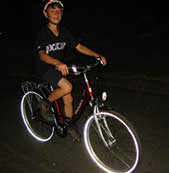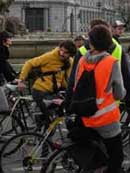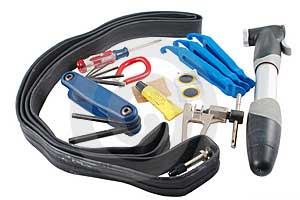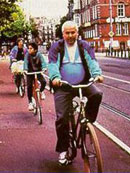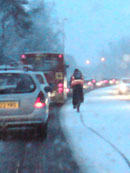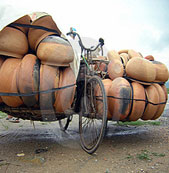Staying Safe on the Road Safety First
With all of its separate bicycle paths, tunnels, and other accommodations, the Netherlands has the lowest rate of cycling accidents in the world. Surprisingly, neither there nor in Denmark, another very safe place to cycle, are cyclists required to wear helmets. And many do not.
|
It is important for bicyclists to wear helmets. The helmet is the only protection for a rider’s head. |
But think about this for a moment. These countries have a cycling culture. In the Netherlands, 30% of all trips are made by bicycle; in Denmark, 20%. Noncyclists know to watch out for cyclists on the road. And these cyclists have many opportunities to avoid the roads.
In most countries, the cycling conditions are less than ideal. Therefore, the first rule of cycling safety is: Wear a helmet. It should be a bicycle helmet, and it should fit properly. If a cyclist takes a spill or collides with another vehicle or a pedestrian, a helmet will reduce the chances of head or brain injury by an estimated 63% to 88%. Helmets are mandatory for all cyclists in many countries and in many U.S. states. Even where helmets are not required for adults, they are for children.
|
A bicycle must be equipped with a lamp and reflectors for night riding. |
Reflective vests in bright colors make bicyclists more visible on city streets. |
Cyclists should do everything possible to make themselves visible, because in most countries with a lot of automobiles, bicycles are all but invisible to others on the road. Reflective vests, reflective strips on the helmet, and bright- or light-colored clothing all make bicycle riders easier to see. The bicycle should also be equipped with the necessary reflectors as well as front and rear lights, which are essential for riding at night. However, if possible, do not cycle after dark.
Bicyclists need to preplan their route. Bicycles are often banned altogether from major highways, unless those roads have separate bicycle sidepaths. Different rules apply for motorized bicycles. In general, motorized bikes are banned from cycle paths but allowed in bike lanes.
It is important to know the rules of the road. Bicycles must follow the same rules as other vehicles, such as traveling with the flow of traffic and observing traffic signals. In most places, pedestrians and motor vehicles always have the right-of-way over bicycles.
|
Cyclists should carry a bicycle repair kit, which includes an air pump and flat-repair equipment. |
|
|
|
Cyclists need to make sure their bicycles are in good repair before they set out. A brake failure could be catastrophic, but even changing a flat tire can put a cyclist in danger of being hit by an unaware motorist. Flats should be repaired well off the road. Cyclists can carry an air pump and a flat-repair kit.
Bicyclists need to be aware of everything around them: other cyclists, motorcycles and mopeds, cars and trucks and buses, pedestrians, even animal-pulled carts and rickshaws. This means no headphones or cell phones.
|
Bicycle riders in the Netherlands often have their own lanes on main roads. Note that helmet use is recommended, even with bicycle lanes. |
While on the road, bicyclists must ride in single file and should keep to the edge of the road unless turning. Both hands should remain on the handlebars unless the rider is signaling. Riders should look to the front and back before making turns. Riding along the edge of the road has special hazards. A pedestrian could step off the sidewalk in front of the bicycle, or the occupant of a parked car could suddenly open a door.
Many collisions occur at intersections where streets meet. The safest way to cross an intersection is by walking the bicycle. If cyclists choose not to do this, they must pay attention to the wheels of vehicles traveling by. Another trick in heavy traffic is to catch the eye of drivers to alert them to the presence of a bicycle. A horn or bell is also useful for this.
|
Riding a bicycle in bad weather, such as a snow storm, is not recommended. The roads become very slippery. |
Bicycles should not be overloaded with cargo. |
Watch out for bad road conditions. The dangers of snow and ice and wet surfaces are obvious. Potholes, cracked pavement, tree roots, and debris in the roadway are all hazards. In cities, so are grates, manhole covers, and tram tracks.
If a bicycle rider decides to carry a small child on the bicycle, she or he should be strapped into an approved seat (different types are attached either behind or in front of the rider) and wear a properly fitting helmet. Be aware that even a small passenger alters the balance and handling of the bicycle, so practice carefully before venturing out.
There are many countries in the world where cyclists carry all manner of cargo and sometimes an adult passenger as well as a child. Loading the bicycle makes it harder to control, and cycling becomes riskier than usual.
There are some riding techniques cyclists use to go faster that are actually very risky. Cyclists should leave drafting to the professional riders. Riding too close to other cyclists is dangerous; even the professionals have frequent pile-ups. Riders should never weave in and out of the traffic, going between cars and trucks and buses. This makes a cyclist even less visible than usual. Finally, a cyclist should never, ever hitch a ride by holding on to the back of a truck or car. This is extremely dangerous.
|
|
|
 |
Digging DeeperFind out more about |
|
|
|
This content has been re-published with permission from SEED. Copyright © 2025 Schlumberger Excellence in Education Development (SEED), Inc.



